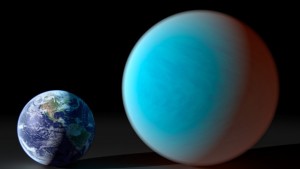THURSDAY, 25 OCTOBER 2012
Lead researcher Nikku Madhusudhan, described the planet as having a “fundamentally different chemistry from Earth”. Rather than the surface comprising of water and granite, it is actually likely to be covered in diamond and graphite, with a whole third of its mass consisting entirely of diamond.Found in the constellation of Cancer and visible to the naked eye, 55 Cancri e is classed as a ‘Super-Earth’ with a mass eight times the size of our own planet. Its surface temperature is thought to be a blistering 2400 Kelvin and the planet also orbits at hyperspeed, meaning its year lasts just 18 hours.
Measurements were made of the planet’s radius for the first time last year, when it was observed transiting the 55 Cancri star. A recent estimate of its mass has now allowed Madhusudhan and his colleagues to compute its chemical composition with a complex algorithm- their results indicating that substantial amounts of carbon and silicon carbide, but a negligible amount of water ice were available during the planet’s formation.
The implications of the calculations serve to dispel the idea that the planet contained a substantial amount of superheated water –a theory based on the assumption that the planet’s chemical makeup was similar to Earth’s. In fact, the new research suggests a complete absence of water on the planet.
One of the major conclusions of this research is that distant rocky planets should no longer be investigated with “Earth-centric” presumptions, when the characteristics of such planets may be a world apart from our own. The paper has been accepted for publication in Astrophysical Journal Letters.
Written by Laura Stevens.

